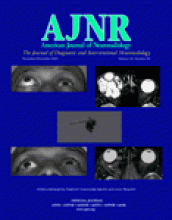Abstract
BACKGROUND AND PURPOSE: Cerebral autosomal dominant arteriopathy with subcortical infarcts and leukoencephalopathy (CADASIL) is a condition causing recurrent subcortical strokes. MR imaging, which shows focal lacunar infarcts and leukoaraiosis, plays a central role in the diagnosis and evaluation. We studied MR imaging abnormalities in a large prospectively recruited cohort of CADASIL patients to describe the spatial distribution of abnormalities, determine how this distribution alters with age, and identify any correlations with the clinical features of the disease.
METHODS: In this study, 112 CADASIL subjects from 64 families were prospectively recruited. MR imaging scans were graded by a single neuroradiologist, by using the modified Scheltens scale, to quantify the severity of high-signal-intensity changes in different brain regions.
RESULTS: Lesion load increased progressively with age. Scores were maximal in the frontal, parietal, and anterior temporal cortex, and the external capsule; intermediate in the pons; and relatively low in the corpus callosum, caudate, globus pallidus, cerebellum, midbrain, and medulla. Anterior temporal pole involvement was common at all ages and, when present, usually confluent, but this was absent in 33% of patients 20–29 years of age. A history of stroke correlated with total Scheltens score and internal capsule and pontine scores. Dementia correlated with total Scheltens score and subcortical white matter score, whereas depression correlated with subcortical white matter score but not total Scheltens score.
CONCLUSIONS: There is a characteristic pattern of MR imaging abnormalities in CADASIL that aids in differential diagnosis; however, some characteristic features, such as anterior temporal pole involvement, can be absent. MR imaging lesion load correlated with some clinical features including stroke and dementia, whereas depression is more common in individuals with deep white matter changes.
- Copyright © American Society of Neuroradiology












